Vienna: Art, Wine and Politics
15 April, 2008, 05:14 am in "Austria"
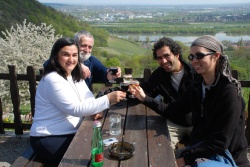 Our friends, Eric and Besra, met us at the train station and took us to their apartment near the center of the town. After a delicious lunch, Besra took us site seeing. We walked through a large street market to the road leading to the center, passing by Jugenstile buildings and the Secession, a building housing the Beethoven Frieze by Klimt.
Our friends, Eric and Besra, met us at the train station and took us to their apartment near the center of the town. After a delicious lunch, Besra took us site seeing. We walked through a large street market to the road leading to the center, passing by Jugenstile buildings and the Secession, a building housing the Beethoven Frieze by Klimt.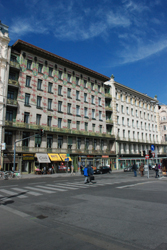
The center was packed with tourists and I saw to my utter disgust, it was infested with human statues.
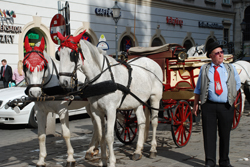
We ducked into St. Stephen's Cathedral, where the exterior was clad in the European building fashion of choice: scaffolding. Stepping into the doorway, we could feel the temperature drop.
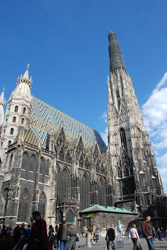
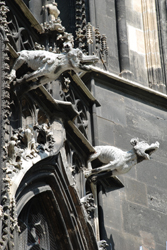
We looked around the cathedral, then walked through a gate into a quiet street which ran next to Mozart's house.
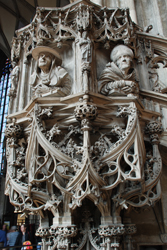
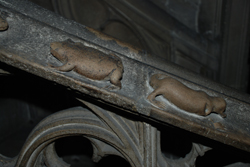
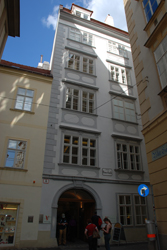
Back on the main square, we stopped to admire a door with ornate metal work.
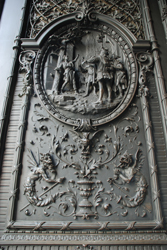
While drinking coffee, we heard sirens and the sound of a protest march. It turned out to be for squatter's rights. Within the next couple days, the news had stories of police and punks fighting. The squatters had occupied an abandoned building which the police raided, dragging the occupants out. We were also pleased to note that Bush was unpopular in Vienna as well as the rest of the world as expressed by a message someone wrote on their roof for when he was in town.
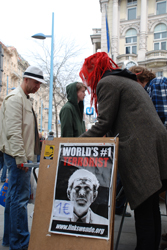
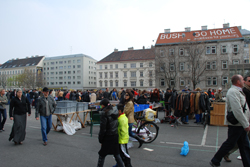
On our way back home we stopped by the Museum Quartier, a center with art museums, as well as other cultural spaces, as well as some other sights.
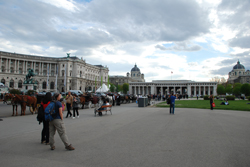
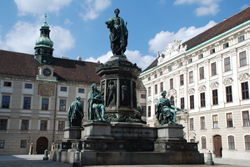
Art in Vienna
Eric is a glass artist. For 25 years he worked as an engraver for a major Austrian glass firm, until he developed a work related hand injury. Now he creates engraved pieces for his own enjoyment as well as other types of glass art. Rowshan became fascinated by the engraving techniques and wondered if it was possible to use the same techniques on ceramics. Eric was delighted by the experiment so on Saturday, he purchased a cheap ceramic mug from the street flea market and we all went to Eric's studio.
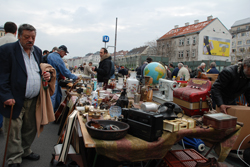
Eric showed us how to engrave glass. He also engraved a bird of Rowshan's design, into a ceramic mug. Both Eric and Rowshan liked the results. Rowshan attempted to engrave a piece of glass but decided it was too difficult.
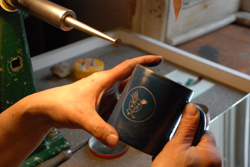
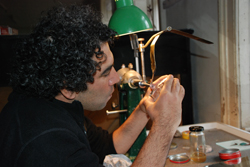
Although I'd been to Vienna before, I found I was a lot more interested in the art this time. We'd briefly touched on Jugenstile, the Viennese Secession, and Wiener Werkstadt in a design history class I'd taken last year, so I enjoyed being able to see examples of architecture and applied arts in these styles. Saturday was the free day at the Museum of Applied and Contemporary arts. Most of the exhibits were rooms full of furniture divided up by style/time: Art Nouveau, Art Deco, Baroque, Rococo, etc. There were also rooms of ceramics, glass and lace. Upstairs I was delighted to find a room with some Klimt paintings (roughs for a frieze) and a couple Glasgow School pieces including a frieze I recognized from my graphic design history textbook. There was a room devoted to carefully crafted Wiener Werkstadt samples. The early 1900s must have been a fun time to be in the Vienna art scene.
On Monday I went to the Leopold Museum. I went for the Klimt works but found the pieces by Egon Schiele and Albin Egger Liennz a lot more captivating. The first room of Schiele was mostly dark landscapes in muted or warm brown tones with an occasional splash of bright color. His people seemed ominous and distorted. I guess that seems to be a characteristic of expressionist painting.
Liennz's pieces were fascinating in how he changed during WWI from a realistic (romantic) painter of Tyrolean pastoral scenes to an expressionist painter of the tragedy of war. After working as a battleground painter, his figures became darker and distorted. His scenes became reductive and his strokes heavier.
The Leopold Museum is in the Museum Quartier, a place I decided I liked a lot. The buildings create a courtyard where people lounge on benches. All around are museums, art studios, and creative spaces. One space I went into had an interesting exhibit where touching plants caused designs to grow on a screen.
While I was at the museum, Rowshan went to see the UN building and a business complex near the Vienna Needle and the danube park. It was a peaceful place with lots of flowers, art work and birds.
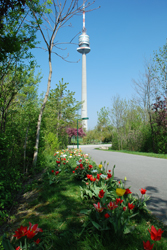
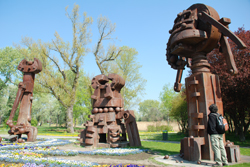
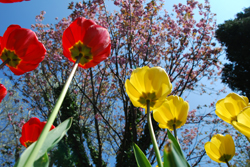
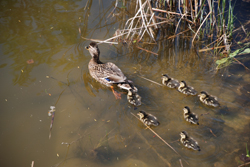
Kallenberg
An important aspect of city life is knowing where to go when one needs to escape the city. Besra and Eric took us to the top of a hill North of the city but easily accessible by public transportation. On the hill, was a church from where the United Christian Kingdoms set out to defeat the Turks and prevent them from taking Vienna. It is also said that when the Turks retreated, they left bags of coffee which introduced the drink to Europe. From the top of the hill, we had a beautiful view of the hazy city below. We walked down the hill. Below us were vineyards. The rows of trimmed, brown vines were separated by strips of dandelions and forget-me-nots. We stopped at a small restaurant selling home-made wine and sat, contentedly sipping wine at an outdoor table, and enjoying the view of the Danube.
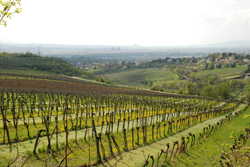
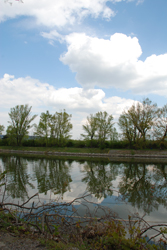
[ View 1 Comments
|
]
Kutna Hora
11 April, 2008, 05:40 am in "Czech Republic"
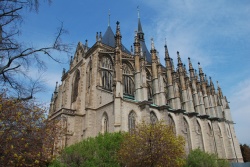 Kutna Hora was a prosperous Medieval town due to its silver mines. Now it still is prosperous due to tourism. The historic center is a 2.5 km walk from the train station past panalaks and rather uninteresting new buildings, with the exception of 2 structures, the Church of the Assumption of Our Lady, a baroque reconstruction of the original Medieval cathedral, and the extremely strange Ossuary of Sedlec. The exterior of the Ossuary is a fairly typical looking chapel. However, the basement is decorated with garlands, a chandelier, pyramids, crosses, chalices and even a coat of arms, all made up entirely of bones.
Kutna Hora was a prosperous Medieval town due to its silver mines. Now it still is prosperous due to tourism. The historic center is a 2.5 km walk from the train station past panalaks and rather uninteresting new buildings, with the exception of 2 structures, the Church of the Assumption of Our Lady, a baroque reconstruction of the original Medieval cathedral, and the extremely strange Ossuary of Sedlec. The exterior of the Ossuary is a fairly typical looking chapel. However, the basement is decorated with garlands, a chandelier, pyramids, crosses, chalices and even a coat of arms, all made up entirely of bones. 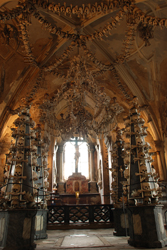
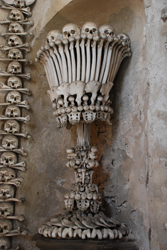
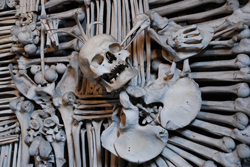
Like other cathedrals the temperature is cooler than the outside air which is warmed by the spring sun. One is immediately faced with the whimsical bone art: The garlands with leg or arm bones hanging like beads from a necklace, flowers or stars made from pelvic bones and sternums, and all manner of creative bone combinations. The majority of the bones (and it is estimated the art is made up of the bones of 40,000 people) make up 4 large pyramids in the corners made from alternating layers of skulls and leg bones. A giant gold crown is suspended above each. There were lots of coins sprinkled about the bone pyramids and I suspect people were trying to toss them into the eye sockets of the skulls, a strange combination of religious prayer offerings and carnival game.
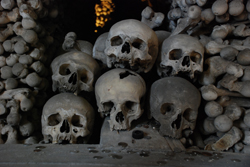
The most elegant piece is a chandelier with "chains" made of jaw bones, arm/leg bone "beads" and skulls for candle holders. The odd thing is instead of looking frightening, the whole arrangement has an odd cheerfulness to it, like party or wedding decorations (Corpse Bride?).
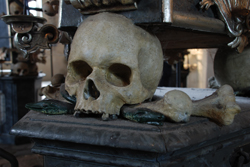
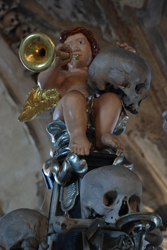
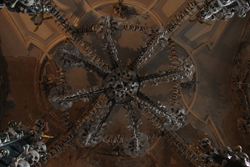
Of course, the big question is probably, "why?" According to an info sheet from the Ossuary, in the 13th century, the abbot of Sedlec went to Jerusalem and returned with a handful of dirt from Golgotha, which he sprinkled over the cemetery. This made it a fashionable place to be buried. In the 14th and 15th centuries, plagues and war brought more dead. Later the cemetery was made smaller. A half blinded monk stacked the bones inside the chapel. In the 18th century, the chapel was rebuilt in the Baroque style and the architect, for some reason, decided that bone decorations were the way to go. Later more decorations, including the coat of arms of the Schwartzburgs (including a rook picking at the eye of a Turk), were added by a carpenter.
From the ossuary, we walked into the historic center of town and headed straight to the Dacicky Pivnice on the recommendation of Denisa and Pavel. It is on Rakova 8, should you ever be in Kutna Hora. This was a very nicely decorated traditional Czech pub/restaurant. The clean light wood interior had numerous woodcut style pictures of dragons, whales, and other scenes. It was definitely touristicized (but in a good way-- the large dining area was non-smoking!). They played good traditional (medieval style) sounding music. In a medieval mood, I chose the wild boar goulash (with cranberries and gingerbread dumplings) while Rowshan had beef goulash with more traditional dumplings. The food was amazing and the staff were friendly. When I asked about the music playing, the waiter said to wait and he'd write down the names of some of the songs. He returned later with a CD of the music I liked which he gave us as a gift. We succumbed to dessert-- hot apple strudel with ice cream-- which we had to consume quickly because the room was filled by a tour group of Russian students.Stuffed and satisfied, we walked to St. Barbara's Cathedral, passing a pretty Gothic water tower on the way.
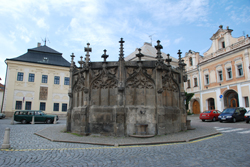
The cathedral was started in the 14th century but, due to interruptions of one sort or another, the work wasn't finished until 1905. Due to this, it has an interesting blend of Gothic structure and frescoes, Baroque decorations (altars, paintings), and Art Nouveau stained glass.
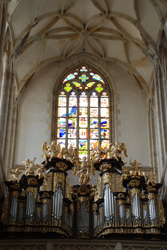
From the outside, it has a strange roof, almost like a circus tent, swooping up to the towers connecting to Gothic structure with the buttresses like leaf tendrils growing off the side of a solid, tan stone building.
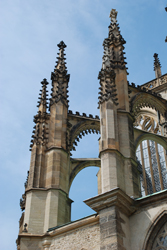
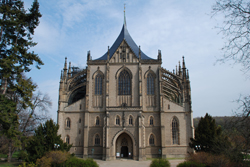
The sides have lots of glass making the stone between seem almost lace like. Long horizontal gargoyles jut from the building.
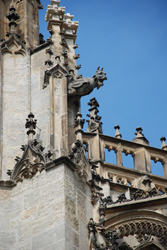
The inside is light filled.
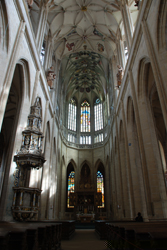
I found the medieval frescoes more humble and prettier than the Baroque pomp.
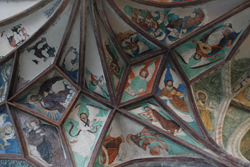
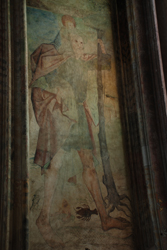
One interesting feature of the cathedral is the miners' chapel--which has frescoes of miner-- and the minters chapel with frescoes of coin makers.
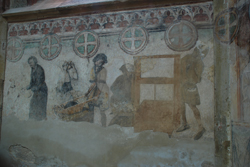
St. Barbara was the patron saint of miners. The cathedral reminded us of how, like Potosi, Kutna Hora was a miners' town. Unlike Potosi, however, the wealth stayed in the town making it prosperous instead of being shipped off to Spain.
We spent the rest of our time enjoying the spring day and the peaceful streets. St. Barbara is perched on a hill overlooking a valley full of trees, whose yellow green new leaves were bursting from the gray gnarled branches. The songs of the birds were so varied it was almost cacophonous.
[ View 1 Comments
|
]
Cesky Raj (Czech Paradise)
10 April, 2008, 02:58 am in "Czech Republic"
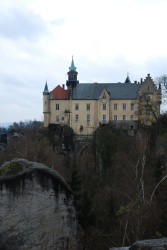 We awoke to a cloudless day and quickly got up to make a 7:15 train to Turnov, in Cesky Raj, "Bohemian Paradise". Though clear, the day was still as cold as the ice blue of the sky. The train passed through industrial looking suburbs of Prague with closed down factories and an occasional building which looked like it had been hit by a bomb. I guess the Czech Republic isn't really as wealthy as the center of Prague suggests. We were relieved as our train rattled into the countryside, where small herds of deer and rather sizable rabbits raced through large fields away from the train. Pheasants strutted and fluttered. The spring green of the fields was broken by flurries of fruit tree flowers, skeletal birch trees, and other trees whose new leaves resembled dust on their branches.
We awoke to a cloudless day and quickly got up to make a 7:15 train to Turnov, in Cesky Raj, "Bohemian Paradise". Though clear, the day was still as cold as the ice blue of the sky. The train passed through industrial looking suburbs of Prague with closed down factories and an occasional building which looked like it had been hit by a bomb. I guess the Czech Republic isn't really as wealthy as the center of Prague suggests. We were relieved as our train rattled into the countryside, where small herds of deer and rather sizable rabbits raced through large fields away from the train. Pheasants strutted and fluttered. The spring green of the fields was broken by flurries of fruit tree flowers, skeletal birch trees, and other trees whose new leaves resembled dust on their branches.Turnov didn't look at all like the pastoral memory I had of Cesky Raj. Assuming I must have gotten confused about which town we were supposed to be in, we hopped onto a local train which brought us past forested hills and farms which better fit the image in my memory. We got off at Borek, where we were able to look up at the fort of Trotsky, towering high atop stone pinnacles.
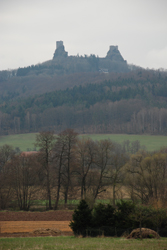
The hills in the distance had a dusting of fresh snow although the fields we walked beside had new grass and plants sprouting. We found a road marked with a trail sign and began walking toward the forested hills. Although it was a paved road, cars were nearly absent so it was a quiet walk. We passed some rows of houses but the only person we saw was an old man who seemed to be trying to tell us something but may have just been drunk.
I was a little worried because we were walking on a paved road when I was sure we should have been on a dirt trail. However, the road did have trail markers on the trees and a sign post pointed to Hruba Skala, the "rock city". The road left the residential area and wound into a forest with tall pine trees. We were relieved to notice some limestone towers and soon we came upon the chateau, a castle out of a fairytale which, although visible from the valley below, appears from the forested side unexpectedly making it easy to imagine the 3rd prince, stuck in a thunderstorm and lost in the forest, stumbling upon it. In reality, it was probably a hunting lodge where 18th century lords and ladies would go to frolic in the woods. Now it is a hotel.
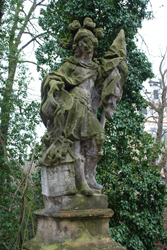
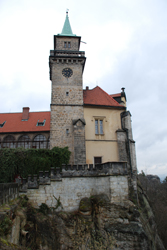
As we approached, it suddenly dawned on me that indeed we had been walking on the same paths I had walked on 13 years ago, except they had paved them and made them into roads. This explained why the roads were marked by trail symbols on the trees.
From the chateau, we descended along a footpath between huge boulders.
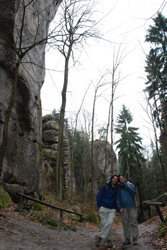
The sandstone towers are pitted by weather and some of the pits have grown into small caves. The odd shaped grayish stones resemble giant trolls who got caught by the sun and frozen. A layer of bright moss coats them in a greenish velvet. The dampness also coats the red and silver tree trunks in a mossy haze. The tall straight pines and stone towers seem to compete in an attempt to reach the light above the forest.
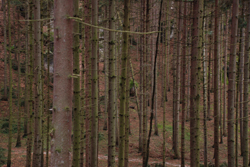
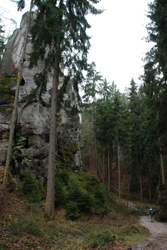
Visitors to the forest in the 19th centuries carved columns, a bed and "lover" statues into the stone.
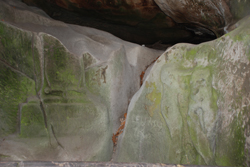
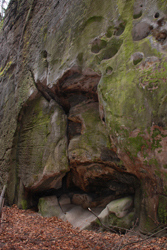
I thought one stone tower resembled Abe Lincoln sans hat.
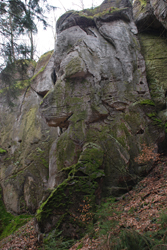
We continued through the forest and found ourselves at another viewpoint of the chateau and rock towers.
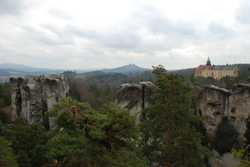
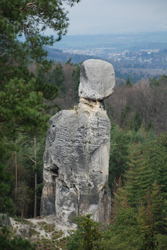
There were barely any people on the paths and only a couple cars on the road. We followed a path down a hill and found ourselves on a children's nature trail.
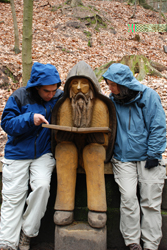
We followed this for a bit then walked up a hill where we were greeted by the sound of chainsaws. As we got closer we saw woodsmen urging horses
to drag heavy logs down a hill to a road.
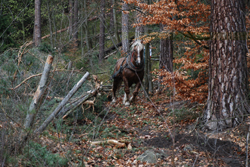
Although generally I'm not fond of logging in natural locations (especially national parks), it seemed that the woodsmen were using very light logging techniques, harvesting individual trees in areas instead of clear cutting huge swaths. We also saw many places where trees had been replanted.
Past the loggers, we came upon Waldstejn castle, another fairytale castle hidden in the woods. It rose from the trees perched on sandstone towers which made its foundation. Some of the stones of the castle are so gray and moss covered it seems like they are becoming part of the rocks the castle is perched on. The original castle was built between 1260 and 1280. However, in the 19th century, "Romantic" structural features were added.
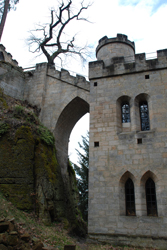
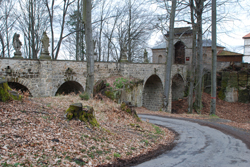
From the castle we walked down the hill to Turnov, which it turns out, was the town I had originally started my hike from in '94. It, of course, had just grown a lot.
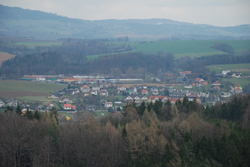
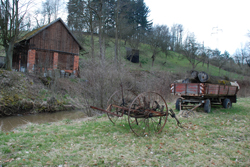
[ View 2 Comments
|
]
Powered by My Blog 1.69. Copyright 2003-2006 FuzzyMonkey.net.
Created by the scripting wizards at FuzzyMonkey.net..
(Code modified by Rowshan Dowlatabadi)
Created by the scripting wizards at FuzzyMonkey.net..
(Code modified by Rowshan Dowlatabadi)

